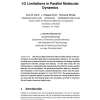Free Online Productivity Tools
i2Speak
i2Symbol
i2OCR
iTex2Img
iWeb2Print
iWeb2Shot
i2Type
iPdf2Split
iPdf2Merge
i2Bopomofo
i2Arabic
i2Style
i2Image
i2PDF
iLatex2Rtf
Sci2ools
178
Voted
SC
1995
ACM
1995
ACM
I/O Limitations in Parallel Molecular Dynamics
Abstract We discuss data production rates and their impact on the performance of scientific applications using parallel computers. On one hand, too high rates of data production can be overwhelming, exceeding logistical capacities for transfer, storage and analysis. On the other hand, the rate limiting step in a computationally–based study should be the human–guided analysis, not the calculation. We present performance data for a biomolecular simulation of the enzyme, acetylcholinesterase, which uses the parallel molecular dynamics program EulerGROMOS. The actual production rates are compared against a typical time frame for results analysis where we show that the rate limiting step is the simulation, and that to overcome this will require improved output rates.
Related Content
| Added | 26 Aug 2010 |
| Updated | 26 Aug 2010 |
| Type | Conference |
| Year | 1995 |
| Where | SC |
| Authors | Terry W. Clark, L. Ridgway Scott, Stanislaw Wloked, James Andrew McCammon |
Comments (0)

